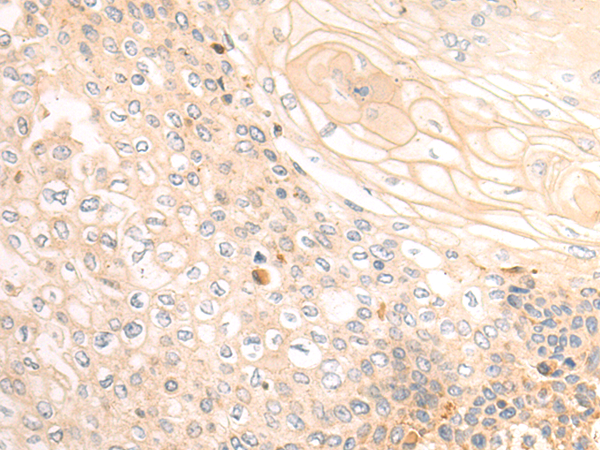
| WB | 咨询技术 | Human,Mouse,Rat |
| IF | 咨询技术 | Human,Mouse,Rat |
| IHC | 1/50-1/200 | Human,Mouse,Rat |
| ICC | 技术咨询 | Human,Mouse,Rat |
| FCM | 咨询技术 | Human,Mouse,Rat |
| Elisa | 1/5000-1/10000 | Human,Mouse,Rat |
| Aliases | MAPE; OIP4; CT130; OIP-4 |
| Host/Isotype | Rabbit IgG |
| Antibody Type | Primary antibody |
| Storage | Store at 4°C short term. Aliquot and store at -20°C long term. Avoid freeze/thaw cycles. |
| Species Reactivity | Human |
| Immunogen | Fusion protein of human PRAME |
| Formulation | Purified antibody in PBS with 0.05% sodium azide and 50% glycerol. |
+ +
以下是3篇与PRAME抗体相关的代表性文献(信息经过简化整理):
---
1. **文献名称**:*PRAME immunohistochemistry in melanocytic tumors: A review*
**作者**:Lezcano C, et al.
**摘要**:该综述总结了PRAME抗体在黑色素细胞肿瘤中的应用,发现PRAME在转移性黑色素瘤中高表达(阳性率>85%),而在良性痣中多为阴性,提示其可作为鉴别良恶性黑色素瘤的标志物。
---
2. **文献名称**:*PRAME expression in myeloid neoplasms: A potential marker for minimal residual disease*
**作者**:Garcia-Castro A, et al.
**摘要**:研究使用PRAME抗体检测急性髓系白血病(AML)患者骨髓样本,发现PRAME高表达与不良预后相关,并证实其在微小残留病灶(MRD)监测中的潜在价值。
---
3. **文献名称**:*Utility of PRAME and SF3B1 immunohistochemistry in the diagnosis of uveal melanoma*
**作者**:Roberts JA, et al.
**摘要**:通过比较PRAME抗体与其他标志物(如SF3B1),发现PRAME在葡萄膜黑色素瘤中的表达与肿瘤转移风险显著相关,且免疫组化检测具有高特异性。
---
如需具体文献DOI或发表年份,可进一步补充关键词筛选。
The PRAME (PReferentially expressed Antigen in MElanoma) antibody is a diagnostic tool used to detect the PRAME protein, a cancer/testis antigen encoded by the *PRAME* gene. PRAME is normally expressed in testicular germ cells and placenta but is silenced in most healthy adult tissues. However, it becomes aberrantly overexpressed in various malignancies, including melanoma, leukemia, sarcoma, breast, lung, and ovarian cancers. This tumor-specific expression profile makes PRAME a valuable biomarker for cancer diagnosis and research.
PRAME antibodies are widely used in immunohistochemistry (IHC) to identify PRAME protein in tumor tissue samples. In melanoma, PRAME helps distinguish malignant lesions from benign nevi, as it is highly expressed in melanoma but absent or low in most benign melanocytic proliferations. It also aids in diagnosing other PRAME-positive tumors and monitoring minimal residual disease. Compared to traditional markers like S100 or HMB-45. PRAME exhibits higher specificity in certain contexts, particularly for metastatic melanoma.
Beyond diagnostics, PRAME's role in tumorigenesis—such as repressing retinoic acid signaling to promote cell proliferation—has spurred interest in its therapeutic targeting. PRAME antibodies also support research into its prognostic value, as overexpression often correlates with aggressive disease and poor outcomes. Ongoing studies explore PRAME as a potential immunotherapeutic target for vaccines or CAR-T therapies.
×